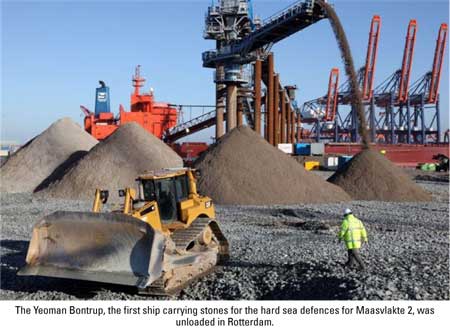The PUMA contractors’ consortium built a special docking area for the stones on the western side of the Yangtzehaven on the existing Maasvlakte. The bulk carriers loaded with stones moor here on poles and then the cargo of 90,000 tonnes of rubble is unloaded within 36 hours via a conveyor belt. Whilst the ship is busy collecting a new shipment of stones, the rubble is taken to a sieving installation, by means of large dumpers. The storage site is about 1.5 km from where the hard sea defences (‘dyke’) for Maasvlakte 2 will be built this spring. For safety’s sake, a temporary viaduct will be built over Europaweg in the coming months, between the storage site and the new hard sea defences.

The stones are an essential part of these hard sea defences. It will be 3.5 km long and be built on the northwest side of Maasvlakte 2, where the waves are most powerful. PUMA has come up with an innovative design for these defences, comprising:
- a stony dune to a height of NAP (Amsterdam Ordnance Datum) + 14 m with a thick covering layer of rubble (20–135 mm), a so-called cobble beach;
- a block dam to a height of NAP (Amsterdam Ordnance Datum) + 2 m constructed on the slope of the stony dune.
The waves break on the low block dam, so the stony dune (or cobble beach) is hit by a much lighter swell.










